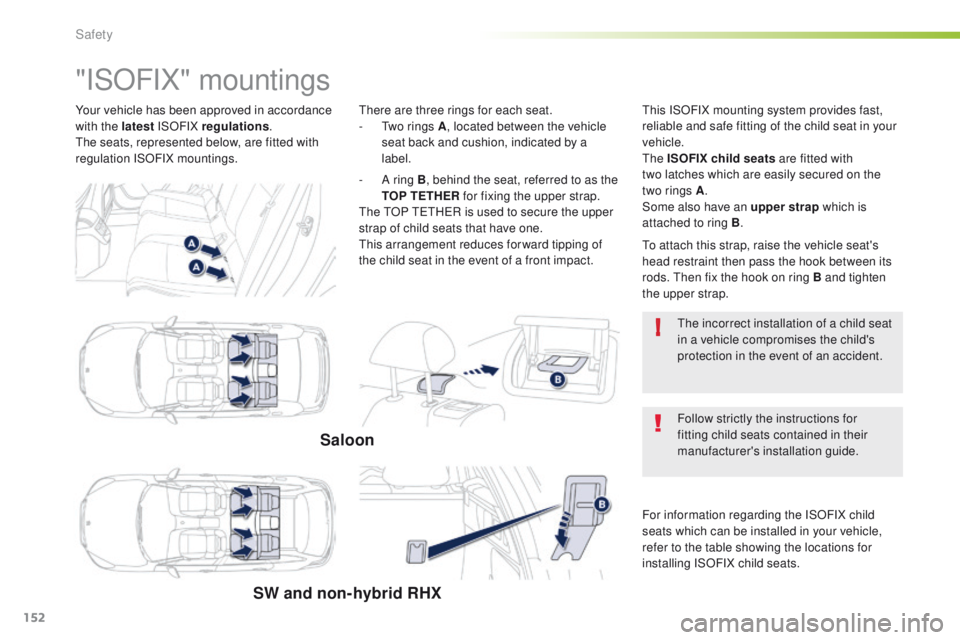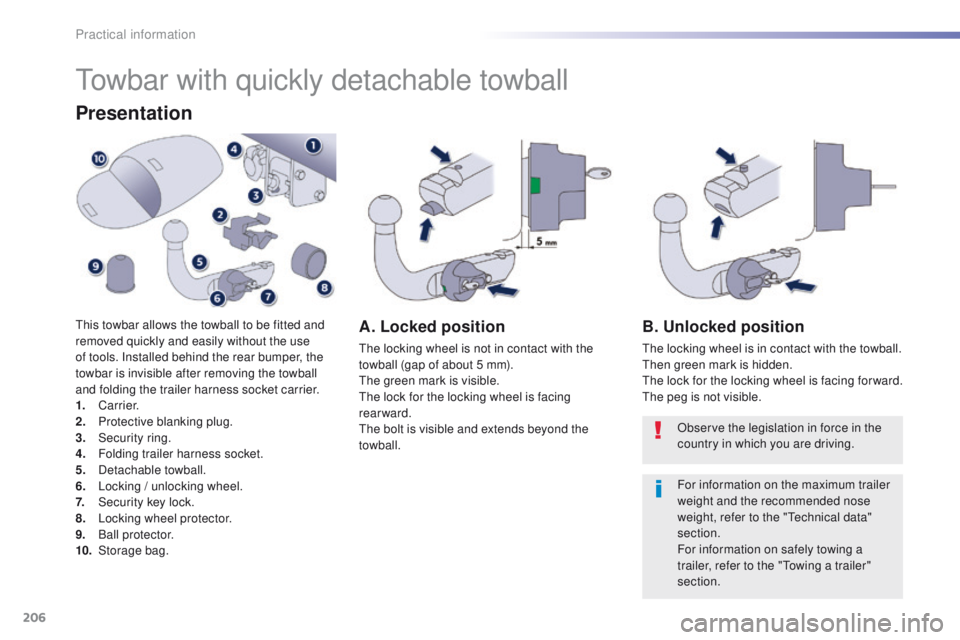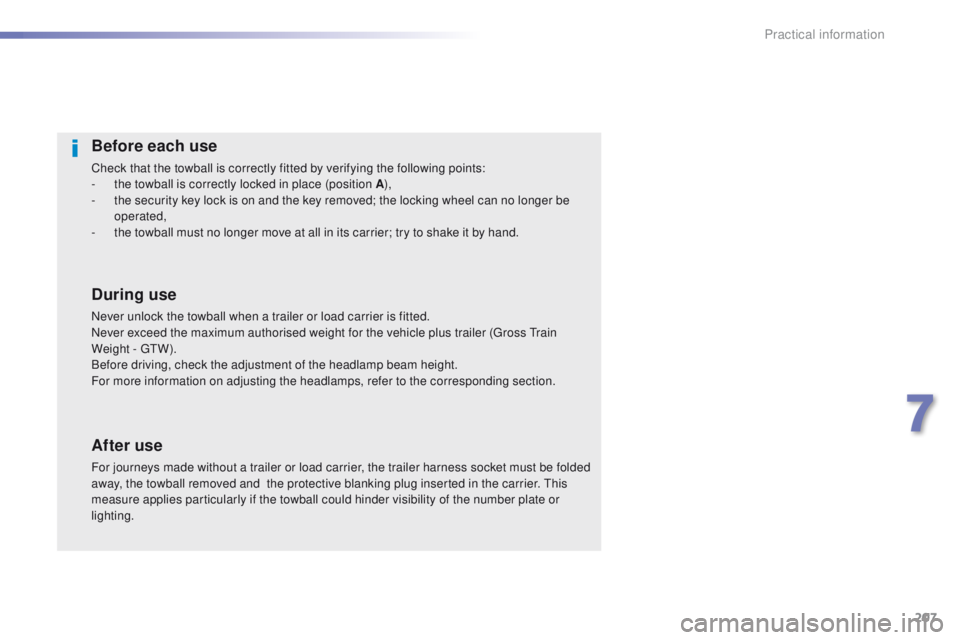Page 153 of 364
151
a: universal child seat, child seat that can be installed in all vehicles using a seat belt.
b:
g roup 0, from birth to 10 kg. Shells seats and baby carriers cannot be installed in the front passenger seat. When installed in the 2nd row, they may
prevent the use of the other seats.
c: consult the legislation in force in your country before installing your child on this seat.
U: seat suitable for the installation of a child seat secured using a seat belt and universally approved, rear ward facing and/or for ward facing.
U (R): idem U , with the vehicle's seat adjusted to the highest position and as far back as possible.
X: seat position not suitable for installation of a child seat for the weight group indicated.
Remove and stow the head restraint before installing a child seat with a backrest on a passenger seat. Refit the head restraint once the child
seat has been removed.
5
Safety
Page 154 of 364

152
!
Your vehicle has been approved in accordance
with the latest ISOFIX regulation s.
th
e seats, represented below, are fitted with
regulation ISOFIX mountings.
"ISOFIX" mountings
there are three rings for each seat.
- tw o rings A , located between the vehicle
seat back and cushion, indicated by a
label.th is ISOFIX mounting system provides fast,
reliable and safe fitting of the child seat in your
vehicle.
th
e ISOFIX child seats are fitted with
two
latches which are easily secured on the
two rings A .
Some also have an upper strap which is
attached to ring B .
Saloon
SW and non-hybrid RHX
the incorrect installation of a child seat
in a vehicle compromises the child's
protection in the event of an accident.
For information regarding the ISOFIX child
seats which can be installed in your vehicle,
refer to the table showing the locations for
installing ISOFIX child seats.
-
A r
ing B
, behind the seat, referred to as the
TOP TETHER for fixing the upper strap.
th
e
t
O
P
tet
HeR i
s used to secure the upper
strap of child seats that have one.
th
is arrangement reduces forward tipping of
the child seat in the event of a front impact.
to a
ttach this strap, raise the vehicle seat's
head restraint then pass the hook between its
rods.
t
h
en fix the hook on ring B and tighten
the upper strap.
Follow strictly the instructions for
fitting child seats contained in their
manufacturer's installation guide.
Safety
Page 155 of 364
153
ISOFIX child seats recommended by PeugeOt
"RÖMER Duo Plus ISOFIX"
(size category: B1 )
Group 1: from 9 to 18 kg Is installed only in the forward facing position.
Is attached to the anchorage rings A and the upper anchorage ring B, referred to as the
t
O
P tet
HeR
, using an upper strap.
th
ree seat body angles: sitting, reclining, lying down.We recommend the lying down position.
th
is child seat can also be used on seats not equipped with ISOFIX mountings. In this case, it must
be secured to the vehicle's seat by the three-point seat belt. Adjust the position of the vehicle's front seat so that the child's feet are not touching the backrest.
P
e
uge
Ot
offers a range of ISOFIX child seats listed and type approved for your vehicle.
Refer also to the child seat manufacturer's fitting instructions for information on installing and removing the seat.
5
Safety
Page 156 of 364

154
Baby P2C Mini and its ISOFIX base
(size categories: C, D, E )
Group 0+: from bir th to 13 kg
Installed rear ward facing using an ISOFIX base which is attached to the anchorage rings A .
th
e base has a support leg, adjustable for height, which sits on the vehicle's floor.
th
is seat can also be secured with a seat belt. In this case only the seat shell is used.
"Baby P2C Midi" and its ISOFIX base (size categories: D, C, A, B, B1 )
Group 1: from 9 to 18 kg
Installed rear ward facing using an ISOFIX base which is attached to the anchorage rings A .
th
e base has a support leg, adjustable for height, which sits on the vehicle's floor.
th
is child seat can also be used for ward facing.
th
is seat can not be secured with a seat belt.
We recommend that you use the seat in the rear ward facing position up to the age of 3 years.
Follow the instructions for fitting child seats contained in the seat manufacturer's installation guide.
th
e ISOFIX BABY P2C base must be installed in a way that the ISOFIX latches 3, 4 and 5 are visible; the support leg must have 6 holes visible.
Safety
Page 158 of 364
156
I UF: seat suitable for the installation of an I sofix Universal seat, F or ward facing secured using the upper strap.
IL- SU: seat suitable for the installation of an I sofix Semi-Universal seat either:
-
r
ear ward facing fitted with an upper strap or a support leg,
-
f
or ward facing fitted with a support leg,
-
a s
hell seat fitted with an upper strap or a support leg.
For advice on securing of the upper strap, refer to the "Isofix mountings" section.
X: seat not suitable for the installation of a child seat or shell for the weight group indicated.
Safety
Page 159 of 364

157
Child seats
the incorrect installation of a child seat in a
vehicle compromises the child's protection in
the event of an accident.
Check that there is no seat belt or seat belt
buckle under the child seat as this could
destabilise it.
Remember to fasten the seat belts or the
child seat harnesses keeping the slack in
relation to the child's body to a minimum,
even for short journeys.
For the installation of a child seat using a
seat belt, ensure that this is well tensioned
on the child seat and that it is holding the
child seat firmly against the seat of your
vehicle. If your front passenger seat is
adjustable, move it forward if necessary.
At the rear seats, always leave sufficient
space between the front seat and:
-
a r
ear ward facing child seat,
-
t
he feet of a child seated in a for ward
facing child seat.
For this, move the front seat for ward and if
necessary straighten its backrest.
Recommendations
Installing a booster
cushion
As a safety precaution, do not leave:
- o ne or more children alone and
unsupervised in a vehicle,
-
a c
hild or an animal in a vehicle which
is exposed to the sun, with the windows
closed,
-
t
he keys within reach of children inside
the vehicle.
to p
revent accidental opening of the doors,
use the child lock.
ta
ke care not to open the rear windows by
more than one third.
to p
rotect young children from the rays of
the sun, fit side blinds on the rear windows.
th
e chest part of the seat belt must be
positioned on the child's shoulder without
touching the neck.
en
sure that the lap part of the seat belt
passes correctly over the child's thighs.
P
e
uge
Ot
recommends the use of a booster
seat which has a back, fitted with a seat belt
guide at shoulder level.
For optimum installation of the forward facing
child seat, ensure that the back of the child
seat is as close as possible to the backrest
of the vehicle's seat, or in contact if possible.
th
e head restraint must be removed before
installing a child seat with a backrest on the
passenger seat.
en
sure that the head restraint is stowed or
attached securely so that it is not thrown
around the vehicle in the event of sharp
braking.
Refit the head restraint as soon as the child
seat is removed.Children at the front
the legislation on carrying a child on the
front passenger seat is specific to each
country. Refer to the legislation in force in
the country in which you are driving.
Deactivate the passenger's front airbag
when a rear ward facing child seat is installed
on the front passenger seat. Otherwise, the
child would risk being seriously injured or
killed if the airbag were deployed.
5
Safety
Page 208 of 364

206
towbar with quickly detachable towball
Presentation
this towbar allows the towball to be fitted and
removed quickly and easily without the use
of tools. Installed behind the rear bumper, the
towbar is invisible after removing the towball
and folding the trailer harness socket carrier.
1.
Carrier.
2.
P
rotective blanking plug.
3.
S
ecurity ring.
4.
F
olding trailer harness socket.
5.
D
etachable towball.
6.
L
ocking / unlocking wheel.
7.
Sec
urity key lock.
8.
L
ocking wheel protector.
9.
Ba
ll protector.
10.
St
orage bag.A. Locked position
the locking wheel is not in contact with the
towball (gap of about 5 mm).
the
green mark is visible.
th
e lock for the locking wheel is facing
rearward.
th
e bolt is visible and extends beyond the
towball.
B. Unlocked position
the locking wheel is in contact with the towball.then green mark is hidden.
th
e lock for the locking wheel is facing for ward.
th
e peg is not visible. Observe the legislation in force in the
country in which you are driving.
For information on the maximum trailer
weight and the recommended nose
weight, refer to the "
te
chnical data"
section.
For information on safely towing a
trailer, refer to the "
to
wing a trailer"
section.
Practical information
Page 209 of 364

207
Before each use
Check that the towball is correctly fitted by verifying the following points:
- t he towball is correctly locked in place (position A ),
-
t
he security key lock is on and the key removed; the locking wheel can no longer be
operated,
-
t
he towball must no longer move at all in its carrier; try to shake it by hand.
During use
Never unlock the towball when a trailer or load carrier is fitted.
Never exceed the maximum authorised weight for the vehicle plus trailer (gr oss tr ain
Weight -
gt
W
).
Before driving, check the adjustment of the headlamp beam height.
For more information on adjusting the headlamps, refer to the corresponding section.
After use
For journeys made without a trailer or load carrier, the trailer harness socket must be folded
away, the towball removed and the protective blanking plug inserted in the carrier. th is
measure applies particularly if the towball could hinder visibility of the number plate or
lighting.
7
Practical information